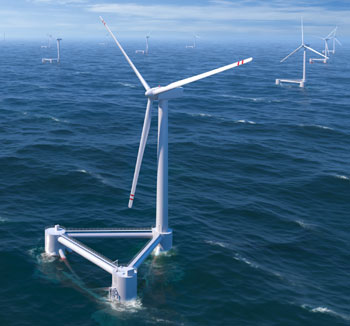The US west coast is the closest its come to getting its first offshore wind farm, a small 30 megawatt (MW) pilot project off the coast of Oregon.
Seattle-based Principle Power wants to build five floating wind turbines 15 miles offshore of Oregon’s Coos Bay. 600-foot tall turbines would connect it to shore via electric cables.
Principle Power received $4 million from the Department of Energy for the project. An environmental analysis of the lease area still needs to be conducted, after which there will be public comment period before a final decision is made.

Why is offshore wind so slow in coming to the West Coast? For one thing, the ocean is much deeper than off the East Coast which prevents turbines from being drilled directly into the seabed. The advent of floating turbines makes it possible for the West Coast. Another reason is that with so much cheap hydropower available, the west hasn’t shown much interest in the very expensive costs to build offshore power.
"It’s not going to be economic out of the gate," Tommy Beaudreau, Director of the Bureau of Ocean Energy Management, told Associated Press (AP). But "it’s important for Oregon to be on the edge of what could be a huge industry in the future."
"We’re not as anxious to commercialize it, but it’s still worth getting the projects into the water and testing them," Belinda Batten, director of Northwest National Marine Renewable Energy Center at Oregon State University, told AP. "As we learn how to deploy and maintain them, the price will come down."
Another reason why floating wind turbines are an important advance is their ability to lower the cost of offshore wind power. It’s much less expensive to build floating turbines that to drill them into the seabed, and they can be towed back to land if they need to be repaired.
Fishermen are supportive of the project, but expressed concerns, such as potential bird collisions and whether the sound or electricity will have a negative impact on sensitive species like salmon, Dungeness crab and whales.
"We’re hoping to learn from this… whether it justifies wrecking prime fishing ground, displacing people and jobs,"
Steve Bodnar, executive director of the Coos Bay Trawlers’ Association, told AP.
On the East Coast, Cape Wind – delayed for 12 years – has finally begun construction of foundations and other components, allowing it to qualify for tax credits before they expired at the end of 2013.
Even though the project still faces multiple lawsuits, Cape Wind contracted with Siemens to supply and maintain 130, 3.6 MW turbines.
This deal and Siemens’ proposal to take a $100 million equity stake in the project raises the chances the project will move forward. Its 3.6 MW turbine is the workhorse of offshore turbines, installed at more sites in the world than any other, including the world’s biggest offshore wind farm in England.
Also on the East Coast, Deepwater is moving forward off the coast of Rhode Island.

Storms, anyone? Results? Turbines in storms? We can’t always keep ships on the top of the water, let alone the blades of turbines.
Let me get this straight. Wind farms have destroyed thousands of acres of the lands of this state and now they are going to destroy the animals and fishing in the oceans. All for the sake of keeping those sucking at the public trough with more handouts.